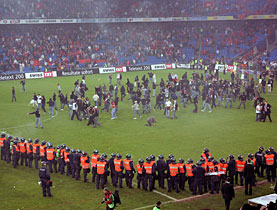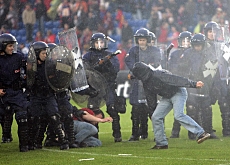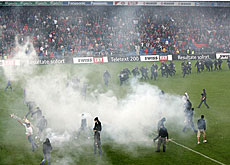Football hooliganism is still alive and kicking

Football-related violence has fallen slightly over recent years but has also fragmented and now affects most first division teams, warns a Swiss sociologist.
The trial of 26 Basel FC football fans, accused of violence after their team lost to Swiss champions FC Zurich in May 2006, is underway in Basel. The incident was described as one of the worst episodes of post-match violence in Switzerland.
The list of charges against the 25 men and one woman include rioting, violence, threats, attempted bodily harm with dangerous objects, damaging property, throwing flares and fireworks, and endangering human life.
On May 13, 2006, rioting broke out immediately after the title-decider between FC Basel and FC Zurich, won in the dying moments by Zurich, 2-1.
Inside the stadium police used rubber bullets and water cannon to contain the violence after hooligans and disappointed Basel fans stormed the pitch and attacked police.
A police cordon guarded the 500 Zurich supporters who had travelled to Basel for the match, but the security forces could not hinder the scenes of chaos which unfolded outside the stadium, despite deploying water cannon and tear gas against crowds throwing bottles and stones.
Around 100 people were injured, 15 of whom were taken to hospital. Damage to the St Jakob stadium was estimated at SFr400,000 ($344,100).
The trial, which began on Monday, is due to run until November 6.
Changed perception
According to Thomas Busset, who has written an academic study on Swiss hooligans, the Basel incident had a profound influence on the authorities’ view of football-related violence and their willingness to act.
“Switzerland has been affected by hooliganism since the start of the 1980s and there have been serious incidents like this one at regular intervals,” he told swissinfo. “But what has changed is the perception of the events. This time the authorities took things in hand and decided to act effectively, with serious consequences and using repression.”
Two months after the events, the Swiss Football League unveiled tougher measures against hooligans. Clubs are now more responsible for their fans when they play away games, meaning they have to organise the ticket sales for their sections of the away stadium themselves.
The guest club also has to take the personal details of their fans as well as provide somebody from the club to accompany the supporters and record violent incidents. An anti-violence campaign and mobile cameras, financed by the league, were also introduced.
These initiatives came on top of a series of measures approved by parliament in 2006 to crack down on violent fans, including a national hooligan database, travel restrictions for known troublemakers and increased police powers.
Calm down lads
So has this volley of measures managed to calm the situation?
“Football-related violence has not ceased; there are still incidents throughout the championship,” said Busset, who is a researcher at the International Centre for Sports Studies, attached to Neuchâtel University.
“It now affects almost all teams in the top division and there is a multiplication of less spectacular local incidents, which together add up. There are regular problems but at a much lower level.”
Football-related violence in Switzerland, where militant fans are inspired by English hooligans as well as southern European “ultras”, is evolving, explained Busset. The problem has fragmented and clashes are difficult to predict and manage.
“We haven’t had many incidents inside stadiums,” said Roger Müller, spokesman for the Swiss Football League (SFL).
“But the problem has relocated itself outside and there have been a number of violent incidents at train stations, for example.”
Most clashes involve the police and a particular group of fans, or rival football hooligan groups meet up far away from the stadiums to fight, even if there is no game.
Violent fans come from across the social spectrum. They are mostly male, young – 15-30 years old – “not dropouts” and “looking for extreme emotions”, said Busset.
“One of the big problems is that these supporters think they are important and the club belongs to them,” he said.
New campaigns
Rather than add to the growing list of anti-hooliganism measures, the SFL is currently planning a new anti-flare and firework campaign in stadiums and is working to improve the tricky implementation of existing measures.
“Outside the stadiums we need to improve our cooperation with the police forces and local authorities,” admitted Müller.
“No one has the miracle recipe for solving football-related violence”, said Busset. “But I think measures such as “fan coaches” [a scheme introduced in Germany and present at clubs in Basel, Bern, Lucerne, St Gallen and Zurich, whereby social workers work to improve dialogue between the club and the fans] is a way of reducing the problem.
“For the medium term it will continue to be a mixture of repression and prevention.”
swissinfo, Simon Bradley
FC Zurich defeated FC Basel 2-1 on the final day of the Swiss Super League season.
The victory gave Zurich their tenth title in club history, and the first since 1980/81.
Basel had been hoping to secure their third championship in a row.
It also ended Basel’s home-winning streak at 59 games.
It was the first loss for Basel at St Jacob’s Park since December 2002.

In compliance with the JTI standards
More: SWI swissinfo.ch certified by the Journalism Trust Initiative












You can find an overview of ongoing debates with our journalists here . Please join us!
If you want to start a conversation about a topic raised in this article or want to report factual errors, email us at english@swissinfo.ch.